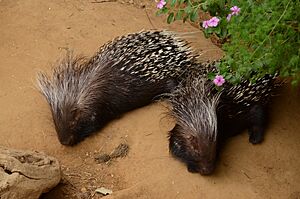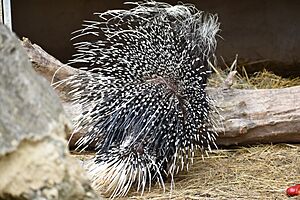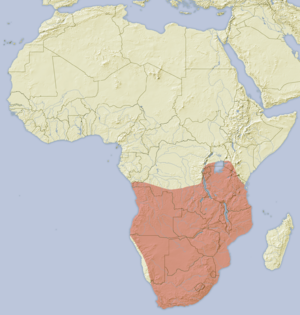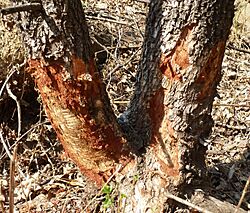Cape porcupine facts for kids
Quick facts for kids Cape porcupine |
|
|---|---|
 |
|
 |
|
| Conservation status | |
| Scientific classification | |
| Genus: |
Hystrix
|
| Species: |
africaeaustralis
|
 |
|
| range | |
The Cape porcupine (Hystrix africaeaustralis), also called the Cape crested porcupine or South African porcupine, is a type of Old World porcupine. It lives in central and southern Africa.
Contents
What is a Cape Porcupine?
Cape porcupines are the biggest rodents in Africa. They are also the largest porcupines in the world! Some other rodents, like the capybara and beavers, can be heavier.
These porcupines look a lot like their close relatives, the crested porcupines. You can tell them apart by a band of short white spines on the Cape porcupine's back.
How Big Are They?
Cape porcupines are about 63 to 81 centimeters (25 to 32 inches) long from head to tail. Their tail adds another 11 to 20 centimeters (4 to 8 inches).
They usually weigh between 10 and 24 kilograms (22 to 53 pounds). Some very large ones can weigh up to 30 kilograms (66 pounds)! Males and females are usually about the same size.
What Do They Look Like?
Cape porcupines are strong, heavily-built animals. They have thick bodies, short legs, and a tail that is hard to see.
Their bodies are covered in long spines, up to 50 centimeters (20 inches) long. Mixed in with these are thicker, sharp quills, up to 30 centimeters (12 inches) long. They also have bristly, dark fur.
The spines on their tail are hollow. They use these to make a rattling sound to scare away predators. A crest of long, bristly hairs runs from their head down to their shoulders.
The quills have black and white bands. They grow in rows along the animal's body. Each row holds five to eight quills. The rest of their body, including their belly, is covered with dark hair.
Their eyes and ears are quite small. They have short whiskers that can move. Their feet have five toes with claws.
Where Do Cape Porcupines Live?
Cape porcupines live all over southern and central Africa. Their range goes as far north as southern Kenya, Uganda, and the Democratic Republic of the Congo.
They can live in many different places, from sea level up to 2,000 meters (6,500 feet) high. However, they usually avoid thick forests, very dry deserts, and swamps.
What Do Cape Porcupines Eat and Do?

Cape porcupines mostly eat plants. They enjoy fruits, roots, tubers (like potatoes), bulbs, and tree bark. They have a special digestive system that helps them break down tough plant materials.
Sometimes, they also chew on dead animals and bones. Farmers often see them as pests because they can eat crops and damage trees. However, by eating tree bark, they might help keep the savannah grasslands open and prevent them from becoming dense forests.
Their Daily Life
Cape porcupines are nocturnal, meaning they are active at night. They are also monogamous, which means they usually live as a mated pair. The adult pair takes care of their young together.
Each pair might use up to six different burrows. They work together to protect their shared territory. However, they usually look for food on their own. Both males and females mark their territory with scent, but males do it more often.
Their home area can be quite large, depending on where they live and how much food is available. It can range from at least 67 to 203 hectares (165 to 500 acres).
How Do They Protect Themselves?
When a Cape porcupine feels threatened, it will freeze. If it gets trapped, it can become very aggressive. It will charge backward to stab its attacker with its sharp quills.
If possible, the porcupine might also retreat into its burrow. It will then show only its quills, making it very hard for a predator to pull it out.
How Do Cape Porcupines Have Babies?
Cape porcupines can mate all year round. However, most babies are born during the rainy season, which is between August and March. Females usually have babies once a year, unless they lose their previous litter.
A mother porcupine is pregnant for about 94 days. She then gives birth to one to three young. More than half of the time, she will have just one baby.
Baby Porcupines
Newborn porcupines weigh about 300 to 440 grams (10 to 15 ounces). Their quills are soft at first. They are born with their front teeth already grown. Other teeth start to appear around 14 days old. They have all their adult teeth by about 25 months.
Baby porcupines drink their mother's milk for about 100 days. They grow very quickly for the first 20 weeks. They reach their full adult size and can have their own babies by the end of their first year.
Compared to most other rodents, Cape porcupines live a long time. They can live for ten years in the wild. In zoos, they can live for up to twenty years!



